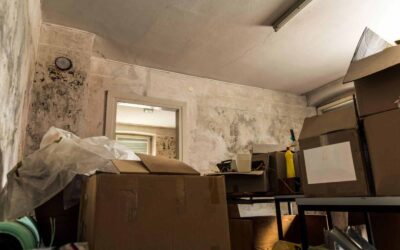Water may seem harmless, but given enough time, it can be an incredibly potent, destructive force. The mighty Grand Canyon was carved by a meager river, after all. While that sort of geological time scale won’t make a difference in our lifetimes, water can wreak havoc on a home in much less time than it takes to carve a canyon. This can lead to costly repairs, extensive mold growth, and even structural damage.
Fortunately, there are steps you can take to safeguard your property from water issues, and in this guide, we’ll explore effective tactics on how to prevent water damage.
Schedule Regular Inspections and Basic Maintenance – Indoors and Out
Preventative inspections and maintenance are some of the best ways to catch potential or minor issues before they turn into major problems. This can be as simple as walking around your house every couple of months to look for potential water damage, or it can involve hiring professional help for less frequent but more rigorous inspections.
Check for Signs of Plumbing Leaks
One particular thing to watch out for is interior plumbing. Older, deteriorating pipes or hidden leaks behind walls and beneath the floor can take some time before they’re apparent, which means that they can lead to significant water damage before you even know they exist. By regularly checking your plumbing, you can locate these issues and then repair them before they get worse.
Inspect the Roof
Major leaks often begin on the roof, so you need to check it for potential entry points. Several times a year, especially before and after the rainy season, inspect the roof for missing, cracked, or otherwise damaged shingles. Ensure that flashing is secure. After rain, check for any signs of sagging or pooling water.
Clean Your Gutters
One of the most startlingly common causes of water overflow is clogged gutters and downspouts, which can lead to water overflow. This can damage your home’s foundation. Clean your gutters and downspouts at least twice a year, ideally in the fall and in the spring, to keep water flowing smoothly and from backing up.
Check the Foundation
When it comes to water and your home’s foundation, small problems can quickly become major ones if not addressed. Small cracks in your foundation can let water seep into your basement and damage the foundation of your house further.
Check Under Sinks
Your kitchen and bathroom sinks are the parts of your home most likely to handle water every day. Even minor leaks under or around a sink can cause mold growth or warp wooden cabinets. Make it a habit to check for moisture under your sinks.
Inspect Appliance Hoses
Washing machines, dishwashers, and refrigerators with water dispensers all have hoses that can become brittle or come loose over time. Replace these hoses several times a decade or if they start showing wear.
Monitor Water Pressure
Overly high water pressure can stress pipes, which increases the likelihood of leaks over time. Use a water pressure gauge to ensure your home’s water pressure is within a safe range: Between 40 and 60 PSI is ideal.
Protect Vulnerable Areas Around Your Home
Places like basements and roofs are especially vulnerable to water damage. You should take proactive steps to protect these areas as well as possible.
Basements
One way to protect your basement is to install a sump pump. In an area prone to heavy rain, this can be a lifesaver. Sump pumps are designed to remove water that accumulates in your basement, keeping it dry.
Sealing walls and floors can also help prevent moisture from seeping through. Use waterproof paint or sealant on basement walls and floors and apply a fresh coat several times a decade.
Since basements can be naturally wet and humid, especially in warmer months, you should run a dehumidifier to keep moisture in check. This reduces the risk of mold or mildew growth.
Better yet is to prevent water from getting into your basement and foundation in the first place. Extend downspouts at least 5 to 10 feet away from your home to prevent water from pooling near the foundation. Ensure your property is graded to slope away from the foundation to help water drain naturally. A slope of an inch per foot for the first 5 to 10 feet is recommended.
Roofs
In colder climates, ice dams can form on your roof, blocking water from draining properly. Installing proper attic insulation and ventilation can regulate the temperature of your roof from the inside, preventing ice dams from forming.
Similarly, leaves, branches, and other fall debris can trap moisture on the roof. Regularly clean your roof, especially after storms, to avoid the risk of water buildup. You may wish to install gutter guards. These can help keep leaves and debris from clogging up your gutters, reducing the need to perform maintenance and improving water flow.
Know the Signs of Water Damage
Spotting early warning signs can save you money in terms of damages and repairs. Watch out for these common indicators of water damage:
- Discoloration on ceilings or walls (especially yellowish or brown stains)
- Peeling paint or wallpaper
- Musty or mildewy odor
- Warped or buckling floors
Other Tips for How to Prevent Water Damage
If you know heavy rain or a storm is coming, you can’t exactly move your home, but you can take some last-minute precautions, like moving valuables to higher ground if you think your basement might flood. Ensure all windows and doors are properly closed and sealed. Adding sandbags around low-entry points won’t completely prevent water from entering the home if flooding is significant, but it will reduce or prevent minor flooding. You can read FEMA’s guide on preventing flood damage for more tips.
You can also take advantage of modern smart home technology, including devices like water leak detectors, smart water shutoff valves, and humidity sensors, to automate parts of the inspection process.
Unfortunately, despite all preventative efforts, water damage can still happen. When it does, contact a professional restoration company immediately. Biodynamic experts can minimize the spread of further water damage, do the cleanup, and help restore your home to its pre-damaged condition.
Preventing water damage requires consistent effort, from regular maintenance checks to knowing the signs of a potential problem. By following these steps on how to prevent water damage, you can do your best to protect the value of your home. You’ll also protect the health of the people who live there.


